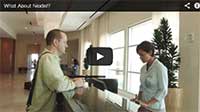
The TRBOCOM
Advantage:
• Low Monthly Cost
• No Per Minute Charges
• Talk - One To Many
• Large Coverage Area
• Extended Battery Life
• GPS & Text Available
Commercial Driver Cell Phone Ban FAQs
Q: What is the effective date of the Mobile Telephone rule?
A: The effective date of the rule is January 3, 2012.
Q: Are wired or wireless earpieces allowed?
A: Yes. Hands-free use of a mobile telephone is allowed using either a wired or wireless earpiece, or the speakerphone function of the mobile telephone. Wireless connection of the mobile telephone to the vehicle for hands-free operation of the telephone, which would allow the use of single-button controls on the steering wheel or dashboard, would also be allowed.
Q: Are commercial motor vehicle (CMV) drivers allowed to use push-to-talk mobile communications equipment while driving?
A: Yes, provided the driver does not reach for, dial, or hold the actual mobile telephone in his/her hand while driving and the driver is able to touch the button needed to operate the push-to-talk feature from the normal seated position with the safety belt fastened. Generally, the use of this type of communications equipment does not require drivers to take their eyes off of the forward roadway because the button used to enable the driver to communicate can be operated from the normal seated position with the safety belt fastened. For example, if the mobile phone is mounted in a cradle or similar device near the driver, or there is a remote push-to-talk button near the vehicle controls to allow the driver to communicate without reaching for, dialing, or holding the actual mobile telephone in his/her hands while driving, the equipment may be used.
Q: Are holders of a commercial driver's license (CDL) subject to the regulation only when driving a CMV, as defined in 49 CFR 383.5, or any vehicle?
A: CDL holders are subject to the Federal rule only when driving a CMV.
Q: What drivers are covered by the Federal rule: intrastate or interstate? CDL holders? All CMVs?
A: This Federal rule covers both, drivers of CMVs in interstate commerce, and also any drivers who operate a vehicle transporting a quantity of hazardous materials requiring placarding under 49 CFR Part 172 or any quantity of a material listed as a select agent or toxin in 42 CFR part 73. If a CMV driver is employed by a State or a political subdivision of a State (e.g. county, city, township, etc.), FMCSA safety regulations do not apply, even if the driver is engaged in interstate transportation. But if a CMV driver employed by a State or a political subdivision of a State is operating a vehicle that requires a CDL, the applicable State traffic laws would govern (e.g., Maryland's prohibition on the use of hand-held phones). The States have 3 years to implement by State law the disqualification provision.
Q: What is required of the employer in terms of company policy or training?
A: The rule does not require motor carriers to establish written policies in terms of company policy or training programs for their drivers. However, employers are prohibited from allowing or requiring their drivers to use hand-held mobile phones. A motor carrier may establish policies or practices that make it clear that the employer does not require or allow hand-held mobile telephone use while driving a CMV in interstate commerce. The carrier is responsible for its drivers' conduct.
Q: Is dialing a phone number allowed under this rule?
A: No. Dialing a mobile telephone while operating a CMV in interstate commerce is prohibited by the rule. A driver can initiate, answer, or terminate a call by touching a single button on a mobile telephone, earpiece, steering wheel, or instrument panel - comparable to using vehicle controls or instrument panel functions, such as the radio or climate control system.
Q: Can a driver reach for a mobile telephone even if he/she intends to use the hands-free function?
A: No. In order to comply with this rule, a driver must have his or her mobile telephone located where the driver is able to initiate, answer, or terminate a call by touching a single button while the driver is in the seated driving position and properly restrained by a seat belt. If the mobile telephone is not close to the driver and operable while the driver is restrained by properly installed and adjusted seat belts, then the driver is considered to be reaching for the mobile phone, which is prohibited by the rule.
Q: Are tow trucks exempt?
A: No. The interstate operation of tow trucks that meet the definition of a CMV are not exempt. Tow trucks, however, are exempt when responding to police emergencies in accordance with 49 CFR 390.23(a)(3).




